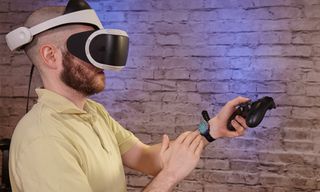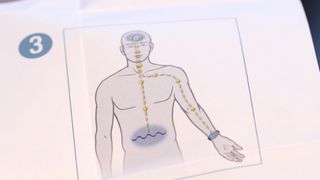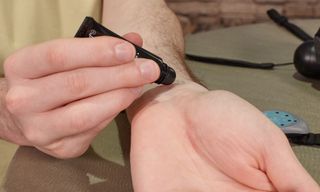Can the Reliefband Cure VR Sickness? Not Mine
While the Reliefband may relieve the nausea some gamers feel when playing VR games, it didn't prove effective in two rounds of our testing.

The first time I ever used a virtual reality headset, I had to sit down with my head between my knees and quaff a ginger ale immediately afterward. That was two years ago, and things haven't improved much since then. But what if fixing VR-induced motion sickness were as simple as slapping on a wristband? I tried out the Reliefband, a $115 wearable that claims to treat motion sickness with electric stimulation, to see if it could really help.
Short answer: no, at least for me. Longer answer: maybe, although it depends on a variety of biological and psychological factors.
I discovered the Reliefband after I came back from yet another trade show, complaining about my VR woes. Video games are my main beat as a journalist, and VR games are a bigger part of the gaming scene than ever before. My colleague Sherri L. Smith had read about the Reliefband online and ordered one so that we could try it firsthand.
UPDATE, 5/11/17: After publishing our original article, Tom's Guide performed additional research and another round of testing.
Virtual Reality, Actual Discomfort
For a small but significant portion of users, virtual reality is almost always a one-way ticket to Queasytown, and there's not a whole lot they can do about it. Enter the Reliefband, a device that claims to treat nausea (brought on by pregnancy, motion or gaming, among other things) by providing a very low-grade electric current to the median nerve in your wrist in a process called P6 electrostimulation (when electricity isn’t involved, it’s simply called P6 acustimulation).

I spoke to Dr. Randy Wexler, a family physician and clinical vice chair of family medicine at The Ohio State University, to learn more about the science behind the illness.
"To understand motion sickness, [you have to] understand how the body recognizes where it is in the 3D plane," Wexler said. He explained that the human body uses three senses to keep track of its position: a tactile sense of standing or sitting (related to the positions and motions of joints, called proprioception), a sense of balance in the inner ear known as the labyrinthine system, and a visual sense used in observing the surroundings.
Sign up to get the BEST of Tom’s Guide direct to your inbox.
Upgrade your life with a daily dose of the biggest tech news, lifestyle hacks and our curated analysis. Be the first to know about cutting-edge gadgets and the hottest deals.
"Motion sickness occurs when these three things do not agree with each other," Wexler said.

For further information, I turned to Dr. Kenneth L. Koch, the section chief of gastroenterology at the Wake Forest School of Medicine in Winston-Salem, North Carolina. In 1990 and 1992, Koch wrote or co-wrote two papers looking at the use of Reliefband (then manufactured by a different company) in treating motion sickness. Both studies were optimistic about P6 electrostimulation, but Koch said he has had no official relationship with Reliefband since then.
"It's the illusion of motion that in some people — not all — is a stress," Koch explained. "The sympathetic nervous system gets cranked up. The stomach's electrical rhythm becomes erratic, [and] you begin to feel and report nausea."
MORE: Oculus Rift vs. HTC Vive
Wexler cited the example of seasickness, which is fairly common among landlubbers. "You may be standing somewhere in the boat, and you don't appear to be moving. Your vision is not moving. But the boat is moving up and down on the waves," he said. Your inner ear picks up on the shift in balance, but your eyes are moving up and down in sync with the boat. "The disconnect between what you're seeing visually and what the balance mechanism in your ears is telling you creates, for some people, motion sickness," Wexler explained.
Round One: Distracting, but not effective
Game developers in the VR space seem keenly aware of the potential for motion sickness. Every Oculus game, for example, has a rating between Comfortable and Intense, which describes just how disorienting the game can become. Even the Comfortable setting, the Oculus site warns, "doesn't mean that an experience is going to be comfortable for everyone."

What's unusual about my VR motion sickness is that nothing in real life fazes my stomach. Boats, cars, trains, planes and roller coasters pose no threat to my lunch. Wexler hypothesized that might be because what's happening in VR is the opposite of what usually happens in real-life motion situations.
"In virtual reality, that visual is right up on you," he said. "Although you perceive distance, there is no distance. It's pounding your visual cortex very closely. … What you're describing is the opposite of the person on the boat." On a boat, the visuals are constant, but the balance is off; in VR, the visuals are in motion, but the balance is constant.
Likewise, Koch told me that it was likely a neurosensory mismatch between motion in the visual system, and a lack of motion in the other two. In his experience, P6 acustimulation could treat some patients with this condition, but not all.
I knew that the only way to test the Reliefband would be to slap it on and dive into a few VR titles. With my colleague Sherri watching (to make sure I didn't puke on anything expensive), I tried two PlayStation VR games that she recommended. The first was a relatively low-impact game: the London Heist mission in PS VR Worlds. The second, Until Dawn: Rush of Blood, was a much more intense experience.
First, the process of putting on the Reliefband is kind of gross. You can't just secure it as you would a wristwatch; you have to lube it up first. (Your first canister of gel is included; replacements cost $15 apiece.) The gel is slick, greasy and unpleasant, and that feeling is doubled if you have arm hair.

It's also not easy to get the Reliefband to sit right. The metal contacts have to be in touch with the lubricated area, but that's hard to accomplish when you need to tighten the fabric strap and fasten the clasp with just one hand. The end result is likely an arm full of rapidly congealing gel and a band that's only somewhere in the general neighborhood of where it's supposed to be.
MORE: 11 Cheap VR Headsets Ranked from Best to Worst
Slapstick antics aside, I finally got the band strapped on and the PS VR headset in front of my face. The London Heist tutorial in PS VR Worlds is simple enough: Grab a gun, and take aim in a shooting gallery full of both stationary and moving targets. As soon as I started looking around the digital warehouse, I felt a little ill and turned the Reliefband onto its lowest setting.
Some regrettable words flew out of my mouth as soon as I hit the power button. The subtle electric current from the Reliefband wasn't painful, but it was definitely unpleasant. The lowest setting felt like someone was digging their nails into my wrist every few seconds. My teeth clenched involuntarily; the muscles in my neck tightened. I wasn't focusing on feeling sick, at least, but the cure was worse than the disease.

I could stand the Reliefband for only a few minutes at a time, but I decided that I had to follow through on my experiment. With Sherri's help, I applied additional gel (it dries out pretty fast) and booted up Until Dawn: Rush of Blood. This game is a much more lighthearted, pulpy take on the point-and-click horror game Until Dawn. Instead of avoiding the killer, though, you take a shooting gallery tour of his deranged brain, speeding through on a roller coaster. For someone who doesn't get along with VR, it's a lost lunch waiting to happen.
This time, I pumped the setting up to 3. The gadget's buzzing and pulsing was uncomfortable, as though someone were pressing down very hard on the veins and arteries in my forearm. Out of curiosity, I turned the device all the way up to 5.
"Painful" is too strong a word, but if you've ever accidentally shocked yourself with a battery or on purpose with one of those silly Lightning Reaction games, you'll know how the fifth setting felt. Something instinctive in my brain was screaming at me to get away from the source of the discomfort, and I did, by turning the settings back down to 3. By comparison, that level felt downright manageable.
MORE: Best VR Headsets
However, a few minutes into my roller-coaster shooting gallery, I noticed that I was still feeling dizzy, sweaty and queasy, right on schedule. The Reliefband had temporarily distracted me from my symptoms, but it hadn't done anything to actually treat them. I felt just as sick as I normally do from virtual reality, and once my initial surprise at the novelty of the Reliefband wore off, I noticed the motion sickness again.
Round Two: A new lab rat
A few weeks later, we decided to get a second opinion on the device. Jorge Jimenez, a lab tester and staff writer for Tom's Guide, shares my propensity for queasiness in VR. After I promised to clean up any lost lunches, he agreed to join me in testing the Reliefband again.
This time, we decided to try two Oculus games labeled Intense, meaning that they feature a lot of action with a fast-moving camera. The first was The Climb, a mountain-climbing simulator; the second was EVE Valkyrie, a space-combat dogfighter (think the X-Wings in Star Wars or the Vipers in Battlestar Galactica).
In accordance with what Reliefband representatives recommended, we each wore the device for 10 minutes before we dove into VR. Jorge told me that the sensation was uncomfortable, though not painful, and I had the same experience when it was my turn.
We played each game for about 30 minutes. Jorge started off feeling fine in The Climb, but as he got higher and higher on the virtual mountain, looking around (and down) brought on that old familiar feeling of nausea, as strongly as ever. The Reliefband, worn properly and turned up as high as Jorge could tolerate, was "distracting," he told me, but not efficacious.
In EVE Valkyrie, Jorge felt fine for the tutorial missions, flying through a series of rings and gunning down stationary targets. As soon as he got into the first mission and started to engage enemy pilots, performing barrel rolls and juking wildly to avoid enemy fire, his good humor deteriorated rapidly. He told me that even with the Reliefband up and running, he felt no different than he had during previous runs of the level, and he was starting to get sick. We pulled off the headset.
Although we found that the Reliefband was most tolerable around level 3, the middle setting, both Jorge and I turned it up to the maximum, 5, to see what it would be like. Our hands buzzed like live wires and made the controllers we were holding shake — another potential pitfall if you're a gamer with a skinny wrist and a predisposition to motion sickness.
My own experience was largely the same as before. After 5 to 10 minutes in each VR game, I felt like I was going to vomit, and the Reliefband did not appear to alleviate my symptoms.
The Sound of Science
I wanted to learn more about the science behind how the Reliefband works. Without going into too much detail, P6 acustimulation is based on the idea from traditional Chinese medicine of "meridians,": invisible lines of "qi," or life energy, that course through the human body. There's little scientific evidence that meridians exist, but there does seem to be something to the P6 pressure point.
Reliefband representatives directed me toward a 2006 metastudy from the Journal of Alternative and Complementary Medicine, a peer-reviewed medical journal that evaluates allopathic medical treatments.
The study ("Cochrane systematic reviews examine P6 acupuncture-point stimulation for nausea and vomiting") said that research on 26 trials and 3,000 patients demonstrated "the superiority of real P6 stimulation over sham for both adults and children and for both nausea and vomiting."
However, that finding doesn't necessarily speak to the Reliefband's efficacy, as the same metastudy said, "Wristwatch-like electrical devices were not effective for any outcome."
The research on P6 acustimulation and electrostimulation often suggests positive outcomes. Even a cursory glance through PubMed will show that P6 acustimulation tends to have a mildly beneficial impact on some individuals experiencing nausea, particularly postoperative patients and people undergoing chemotherapy. After all, nausea itself is not an illness, but a symptom; what works for chemotherapy should also work for motion sickness.

Koch expressed interest in trying out a Reliefband with his own patients but didn't say whether it was a definitive anti-motion-sickness countermeasure.
"It's definitely still being studied," Koch said. "There's always a lot of questioning in science, and you can always do a better study."
On the other hand, Koch himself said he is optimistic about P6 acustimulation in general.
"In the medical field … nausea is a huge problem," Koch said. "We have very few treatments. We have a lot of interest in using nondrug electrical therapies. You'll see some regular output of people trying these nondrug therapies. … Some of the big meta-analyses suggest there is a favorable outcome; it tends to be positive, and I think there is a growing interest [and] acceptance. But it varies."
Bottom Line
Without launching a scientific study of our own, there is no way for Tom's Guide to evaluate whether the Reliefband is generally efficacious in treating VR motion sickness. Still, while Jorge and I didn't get much out of the Reliefband, another person might.
"Everyone has a different sensitivity to these stimulations," Koch said. "You may be really nauseated in a certain setting, and nothing's going to stop it. On the other hand, there may be people who are less sensitive on the continuum, and it [P6 acustimulation] really helps a lot."

For the Reliefband, I can say this much on behalf of Tom's Guide: I tested it twice, found it uncomfortable and didn't feel any better while using it. A co-worker with similar VR triggers felt the same way. The science behind the Reliefband is suggestive but not as conclusive as it could be.
There have been no large-scale studies that evaluate the effects of P6 acustimulation, peripheral-based or otherwise, on VR-induced motion sickness. A gastroenterologist suggested that such a technology could have a positive effect, at least for some people.
Whether you want to spend $115 to find out is, of course, up to you.
Photo credit: Nick Bush and Jeremy Lips/Tom's Guide
Marshall Honorof is a senior editor for Tom's Guide, overseeing the site's coverage of gaming hardware and software. He comes from a science writing background, having studied paleomammalogy, biological anthropology, and the history of science and technology. After hours, you can find him practicing taekwondo or doing deep dives on classic sci-fi.

